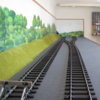Jon Nazareth
Western Thunderer
PS. Actually, I have found a picture of a mess hut located at Hayling Island, at least, I think that's where it is. I'll draw it up and see how it fits.
Jon
Jon










Well the LNW did have a bolster loading guide that referenced wagons running with bolster removed.
Arguably its an easily forgettable concept. Bolster loads arent what we modellers focus on.How embarrassing when it takes somebody the other side of the "pond" to remind me about LNWR wagons. Thank you Trevor!
Mike
